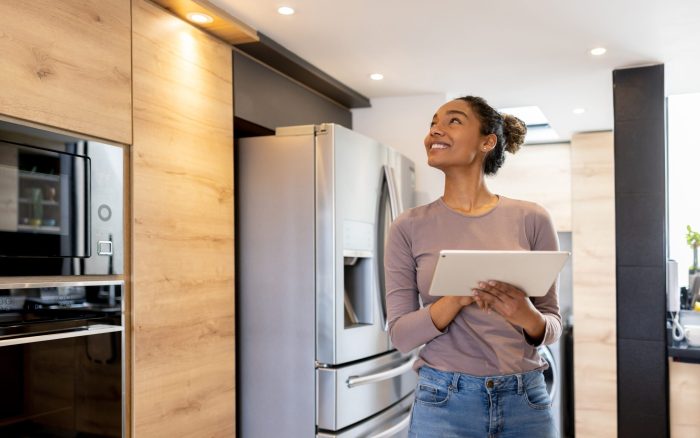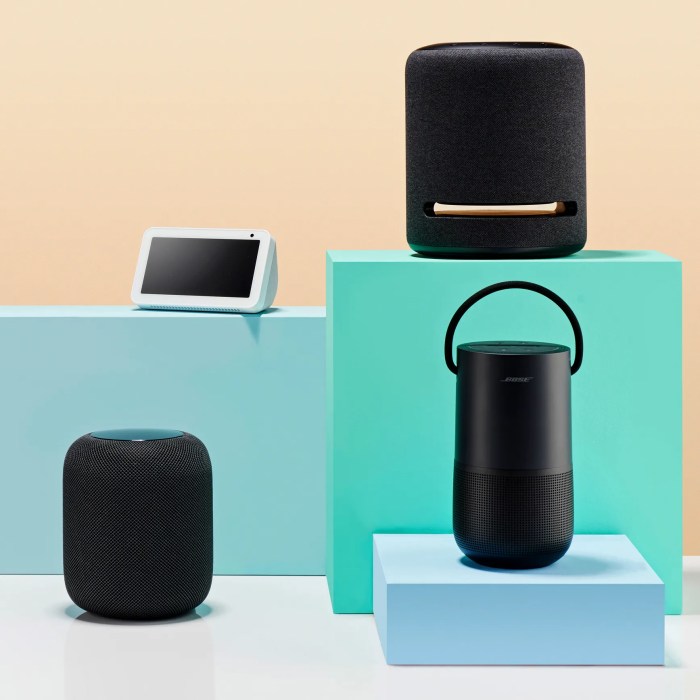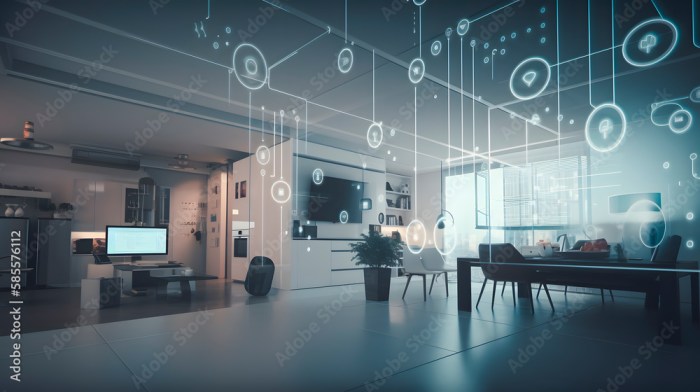internet smart home sets the stage for this enthralling narrative, offering readers a glimpse into a story that is rich in detail and brimming with originality from the outset. In recent years, the concept of smart homes has evolved from a mere novelty to a significant aspect of modern living, enhancing our daily routines through innovative technology. As we explore the components and benefits of this cutting-edge lifestyle, we will uncover how smart home technology integrates seamlessly into our lives, paving the way for a more convenient, efficient, and connected existence.
Overview of Smart Home Technology

Smart home technology represents a transformative shift in how we interact with our living environments. It integrates internet-connected devices that allow users to monitor and control various aspects of their home, enhancing convenience, efficiency, and security. This technology has gained significant traction among consumers, reshaping daily tasks and interactions within the household.Over the last decade, the evolution of smart home technology has been remarkable.
Beginning with basic automation systems, advancements in Internet of Things (IoT) devices, enhanced connectivity, and sophisticated artificial intelligence have propelled smart homes into the mainstream. In the early 2010s, devices like smart thermostats and lighting systems emerged, paving the way for more complex ecosystems that can be controlled remotely or programmed for automated routines. As of 2023, the integration of voice-activated assistants and smart appliances has further refined user experiences, allowing seamless interactions and multitasking capabilities.
Core Components of Smart Home Setup
A smart home is typically characterized by several key components that enable its functionality. Understanding these elements is essential for grasping the full scope of smart living. Below are the primary components that contribute to an effective smart home system:
- Smart Hub: The central unit that connects various smart devices, allowing them to communicate and be controlled from a single interface. Examples include Samsung SmartThings and Amazon Echo Plus.
- Smart Lighting: Intelligent lighting systems that can be programmed for different settings and adjusted remotely. Popular brands include Philips Hue and LIFX.
- Smart Thermostats: Devices like Nest and Ecobee that optimize heating and cooling, learning user preferences to enhance energy efficiency.
- Smart Security Systems: Comprehensive security solutions encompassing cameras, motion detectors, and doorbell cameras that provide real-time monitoring and alerts. Notable examples are Ring and Arlo.
- Smart Appliances: Kitchen and household appliances that connect to the internet, offering remote control and monitoring capabilities. Brands like LG and Samsung have integrated smart technology into refrigerators, ovens, and washing machines.
- Voice Assistants: Digital assistants such as Amazon Alexa, Google Assistant, and Apple Siri that facilitate voice-activated control of smart devices.
Each of these components works together to create a cohesive smart home environment, enhancing the living experience through improved comfort, efficiency, and security.
Benefits of Internet-Connected Smart Homes
The integration of internet connectivity into home devices offers a plethora of advantages, transforming traditional living spaces into innovative, efficient, and highly convenient environments. Smart homes leverage technology to enhance the lifestyle of their residents, making daily tasks simpler while also contributing to sustainability and cost savings.Smart home technology encompasses a variety of devices equipped with internet capability, allowing users to control them remotely via smartphones or other connected devices.
This connectivity leads to significant advancements in energy efficiency and substantial cost savings. By optimizing energy consumption and automating mundane tasks, smart homes contribute to a more eco-friendly and budget-friendly lifestyle.
Energy Efficiency and Cost Savings
The implementation of smart home technology plays a critical role in promoting energy efficiency, leading to notable cost savings. By utilizing smart devices, homeowners can monitor and manage their energy usage more effectively. Below are key aspects of how smart homes enhance energy efficiency:
- Smart Thermostats: These devices learn user preferences and schedule heating and cooling automatically, reducing unnecessary energy use. For instance, a study by Nest showed that users save an average of 10-12% on heating and 15% on cooling bills.
- Smart Lighting: Automated lighting systems can adjust based on occupancy, ensuring lights are off when not needed. This technology can lead to savings of up to 30% in lighting costs.
- Energy Monitoring Systems: These systems provide real-time data on energy consumption, enabling homeowners to identify energy-wasting habits and adjust them accordingly.
- Smart Appliances: Internet-connected appliances, such as refrigerators and washing machines, operate at optimal times and can be controlled remotely, leading to reduced energy usage and costs.
The cumulative effect of these technologies results in a significant reduction in energy consumption, promoting a more sustainable living environment while decreasing utility expenses.
To fully optimize your living space, utilizing a controller smart home is essential. This device acts as the central hub, allowing seamless communication between various smart devices. With intuitive apps and voice commands, managing your home has never been simpler, giving you complete control at your fingertips.
Convenience and Lifestyle Improvements
Smart home technology enhances convenience, providing lifestyle improvements that cater to modern living demands. The ability to manage home systems remotely leads to greater control and ease of use. Key conveniences offered by smart homes include:
- Remote Access and Control: Homeowners can monitor and control various devices from anywhere using mobile apps. This feature is particularly useful for managing security systems and adjusting climate controls while away from home.
- Automation: Routine tasks can be automated, such as setting the coffee maker to start brewing at a specific time or adjusting blinds based on the time of day, which significantly streamlines daily activities.
- Enhanced Security: Smart home security systems provide real-time alerts and video feeds, allowing homeowners to keep an eye on their property from anywhere, increasing peace of mind.
- Voice Control: Integration with virtual assistants like Amazon Alexa and Google Assistant allows for hands-free control of smart devices, making operation simple and intuitive.
These features not only contribute to a more efficient home but also elevate the overall quality of life by providing comfort, security, and ease. The advancements in smart home technology illustrate a significant shift towards a more integrated and user-friendly living experience, aligning with the needs of today’s homeowners.
Common Smart Home Devices: Internet Smart Home
The landscape of smart home technology is enriched by a variety of devices designed to enhance convenience, security, and efficiency in daily living. These devices leverage internet connectivity to provide users with seamless control and automation capabilities. Below, we explore some of the most prevalent smart home devices and their respective functions, along with a comparison of leading smart home ecosystems and insights into the role of smart security systems.
Widely Used Smart Home Devices and Their Functions
With the increasing adoption of smart home technology, various devices have become essential for creating a connected ecosystem. The following list highlights some of the most common smart home devices, along with their primary functions:
- Smart Speakers: Devices like Amazon Echo and Google Nest allow users to play music, set reminders, and control other smart devices through voice commands.
- Smart Lights: Products such as Philips Hue enable users to adjust brightness, change colors, and schedule lighting preferences remotely.
- Smart Thermostats: Devices like the Nest Learning Thermostat help manage home heating and cooling efficiently, learning user preferences over time to optimize energy usage.
- Smart Security Cameras: Brands such as Ring and Arlo provide real-time video monitoring, motion detection, and remote access to enhance home security.
- Smart Door Locks: Products like August Smart Lock allow keyless entry, remote locking, and unlocking, which can be managed via a smartphone app.
- Smart Plugs: Devices such as TP-Link Kasa Smart Plug enable users to control electronic devices remotely, monitor energy usage, and create schedules for operation.
Comparison of Popular Smart Home Ecosystems
Different smart home ecosystems offer various features and compatibility with devices. The two most popular platforms, Google Home and Amazon Alexa, are compared below to understand their strengths and weaknesses.
In today’s modern world, integrating a smarthome device into your daily routine can enhance convenience and security. These devices not only automate household tasks but also provide real-time monitoring, making your life easier. With the right technology, you can control everything from lighting to security systems, making your home smarter and more efficient.
| Feature | Google Home | Amazon Alexa |
|---|---|---|
| Voice Recognition | Advanced natural language processing and context awareness. | Strong voice recognition, especially for shopping and Amazon services. |
| Device Compatibility | Supports a wide range of devices, especially those with Google Assistant integration. | Extensive compatibility with numerous third-party devices and services. |
| Smart Home Control | User-friendly interface for managing devices through Google Home app. | Robust control options with routines and skills available via Alexa app. |
| Music Streaming | Integration with YouTube Music, Spotify, and Google Play Music. | Supports Amazon Music, Spotify, and more with superior speaker options. |
| Security Features | Offers personalized routines and location-based triggers. | Includes Alexa Guard for monitoring and alerting of potential intrusions. |
Role of Smart Security Systems and Their Impact on Safety
Smart security systems play a crucial role in enhancing home safety by providing advanced features that traditional security measures often lack. These systems integrate multiple devices, such as cameras, motion sensors, and smart locks, to create a comprehensive security network.
“Smart security systems empower homeowners to monitor their properties remotely, receive real-time alerts, and manage access, significantly reducing the risk of burglaries and enhancing overall safety.”
With the ability to receive instant notifications on smartphones, homeowners can quickly respond to potential threats, whether they are at home or away. Additionally, many smart security systems offer cloud storage for video surveillance, enabling users to review footage whenever necessary. The implementation of smart security devices has not only deterred crime but also provided peace of mind for families.
As these systems continue to evolve, integrating artificial intelligence and machine learning, the future of home security looks promising and increasingly sophisticated.
Challenges and Concerns in Smart Home Adoption

The integration of smart home technology brings numerous advantages; however, it also presents several challenges and concerns that potential users must navigate. Understanding these complexities is essential for creating a secure, functional, and enjoyable smart home experience. The primary issues revolve around security risks, privacy concerns, and technical difficulties that can impede effective implementation.
Security Risks Associated with Smart Home Devices
Smart home devices are inherently connected to the internet, making them susceptible to various security threats. One significant risk is unauthorized access, which can lead to breaches of personal privacy and data. Cybercriminals often target inadequately secured devices, exploiting vulnerabilities to gain control over home automation systems. Important points to note include:
- Weak passwords used for device login can be easily guessed or cracked using brute force attacks.
- Outdated firmware may contain known security flaws, making devices vulnerable to exploitation.
- Lack of encryption in data transmission can allow hackers to intercept sensitive information.
“The average smart home contains multiple devices, each with potential security vulnerabilities, making it crucial for users to prioritize security measures.”
Privacy Concerns Related to Data Collection in Smart Homes, Internet smart home
The data collection practices of smart home devices raise significant privacy issues. Many of these devices track user behavior and preferences to enhance functionality, but this information can be misused. Key privacy considerations include:
- Devices often gather extensive data on daily routines, which can be exploited if accessed by third parties.
- Users may unknowingly consent to data sharing with manufacturers and service providers, leading to potential misuse.
- Lack of transparency regarding data usage policies can leave users unaware of how their information is handled.
“With increasing reliance on smart technology, the potential for data misuse becomes a pressing concern for homeowners.”
Technical Challenges in Implementing Smart Home Systems
While the promise of smart home systems is appealing, users often encounter technical barriers that hinder successful implementation. These challenges may stem from compatibility issues, network connectivity problems, or user interface complexities. Important technical considerations include:
- Incompatibility between different brands and standards can result in fragmented systems that do not communicate effectively.
- Weak Wi-Fi signals in certain areas of a home can disrupt the functioning of connected devices, leading to frustration.
- Users may struggle with complex setup processes and poorly designed interfaces that complicate device management.
“Navigating the technical landscape of smart home systems requires a certain level of expertise, which can be a barrier for many users.”
Future Trends in Smart Home Technology

The future of smart home technology is poised for remarkable advancements that will redefine how we interact with our living spaces. As innovation continues to accelerate, we can expect an integration of sophisticated technologies that promise to enhance convenience, efficiency, and security. Key trends will emerge, driven primarily by advancements in artificial intelligence and the proliferation of the Internet of Things (IoT) that will shape the next generation of smart homes.
Advancements in Smart Home Technology
The future of smart homes will see devices becoming increasingly interconnected, intelligent, and responsive to user needs. Emerging technologies will introduce the capacity for homes to learn from inhabitants’ behaviors and preferences, allowing for a more customized living experience. Predictions suggest that smart home technology will evolve in several significant ways:
- Integration of Artificial Intelligence: The incorporation of AI will enable devices to analyze data patterns, facilitating proactive responses. For instance, smart thermostats could adjust temperatures based on predicted weather patterns and user routines without manual input.
- Enhanced Voice Control: Voice assistants will become more sophisticated, allowing for more natural interactions. Users will be able to issue complex commands that control multiple devices simultaneously.
- Advanced Security Features: Future homes will benefit from AI-driven security systems that can recognize faces and detect anomalies, sending alerts to homeowners or authorities when unusual activity is detected.
Impact of Artificial Intelligence on Smart Home Functionality
Artificial intelligence will play a critical role in enhancing the functionality of smart home devices. With machine learning capabilities, devices will not only respond to commands but will also anticipate needs based on past user behavior. Smart appliances will be capable of optimizing their operation to save energy and improve efficiency.For example, AI-powered kitchen devices may learn cooking preferences and suggest recipes based on available ingredients.
“AI will transform every aspect of smart home technology, making it not just responsive but also proactive.”
Influence of the Internet of Things (IoT) on Smart Homes
The Internet of Things will be central in shaping the future landscape of smart homes. With more devices capable of connecting to the internet, homes will become a cohesive ecosystem where everything from lighting to security systems can communicate seamlessly.The following aspects highlight the influence of IoT:
- Interconnectivity: IoT will ensure that all devices can work together effortlessly, allowing for automation routines that enhance daily living. For instance, when a user leaves home, the smart security system can lock doors, turn off lights, and set the thermostat to energy-saving mode.
- Real-Time Data Analytics: IoT devices will provide real-time data analytics, allowing homeowners to monitor their energy usage, water consumption, and more, leading to smarter resource management.
- Remote Accessibility: Homeowners will have the ability to control their devices from anywhere, ensuring convenience and peace of mind. Whether it’s adjusting the thermostat while at work or checking security cameras while on vacation, IoT will make this seamless.
The trajectory of smart home technology points toward a future where homes are not just smart, but also intuitive, deeply integrated into the fabric of daily life, and responsive to the unique needs of every inhabitant.